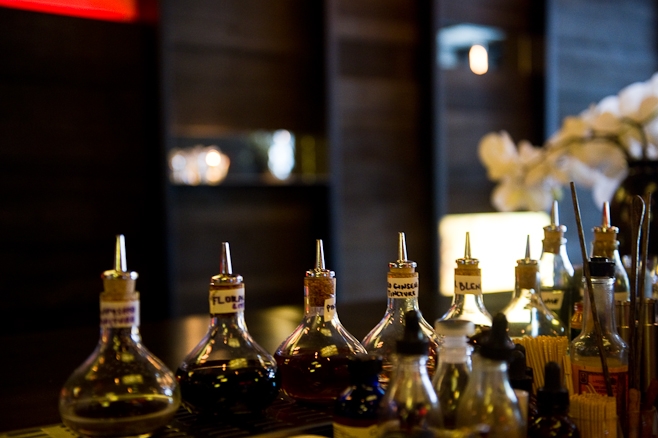HerbalEGram: Volume 7, Number 5, May 2010
Chinese Traditional Herbs in
Cocktails
Herbal medicine comes in many forms: herbs, teas, capsules,
tablets, extracts, and even cocktails. While some alcoholic beverages, like
minty mojitos, have included herbs for generations, a more unique collection of
herbal cocktails has been growing in popularity recently. The addition of traditional Chinese medicinal herbs to
alcoholic cocktails was recently implemented at the Keefer Hotel in the
Chinatown of Vancouver (British Columbia, Canada) by
Keefer bar manager Danielle Tatarin.1
After noticing that herbs used in Traditional Chinese Medicine (TCM) were
often incorporated into teas, Tatarin began experimenting with making these
teas into a syrup,  which she now adds to her Chinese Medicine cocktails.
Previously Tatarin was with the DB Bistro Moderne in Vancouver where she also incorporated herbs
into syrups for cocktails. which she now adds to her Chinese Medicine cocktails.
Previously Tatarin was with the DB Bistro Moderne in Vancouver where she also incorporated herbs
into syrups for cocktails.
“I became interested in mixology and cocktail history
while traveling throughout South East Asia and Australia,” said Tatarin. “I loved
a lot of things I was seeing for the
first time and always wondered ‘how would this taste if I mixed it into a
cocktail?’ Since then I’ve been incorporating herbs into cocktails through teas, syrups,
powders, oils, tinctures and bitters. All of the applications I have
researched on my own and tested recipes through trial and error.”
Tatarin also uses common herbs not exclusive to Chinese Medicine, such as
lavender (Lavandula spp.) and sage (Salvia officinalis), in her cocktails. Though Tatarin is not currently an
herbalist, she was introduced to herbs like lavender, peppermint (Mentha x piperita), and ginger (Zingiber
officinale) at an early age through her stepmother, a nurse who also studied Eastern medicine.
Tatarin’s most in-demand drink is the Opium Sour (recipe
provided by Tatarin below) which is high in vitamins C and B as it
contains both grapefruit (Citrus x paradisi) and tamarind (Tamarindus indica). Its poppyseed (Papaver rhoeas) tincture also helps with
relaxation (although it does not actually contain opium, derived from the opium
poppy, P. somniferum) and overall,
she says, the drink aids digestion. Another of her most famous cocktails—the
Tigers Tail—consists of astragalus root (Astragalus
membranaceus), used in TCM to boost
the immune system and qi (energy), shochu, a distilled Asian beverage (most commonly distilled from barley, sweet
potatoes, or rice), and the alcoholic liquid Campari® (from
global beverage creator Gruppo Campari).1
“I recommend the Tigers Tail for
people with allergies or to boost
the immune system but we can mix the Astragalus tea syrup into any cocktail,”
said Tatarin.
Tatarin also keeps an eye out for
interactions with alcohol. “I haven’t come across any problems with the ones
I’m using now,” she said. “I’m always careful to find out what the uses for each herb are before
mixing it into the drink.”
More information about the Keefer Bar is available at www.thekeefer.com. 
Opium Sour Recipe:
- 3/4 oz Fresh Grapefruit Juice
- 2 dashes Poppyseed Tincture
Shake first 4 ingredients vigorously
on ice for 10 –15
seconds. Strain over fresh ice into a highball glass. Finish with
poppyseed tincture.
*To make tamarind syrup, steep fresh or dried tamarind pulp in hot water for
20 minutes and fine strain through a cheesecloth. Add equal part sugar to
tamarind water.
Tigers Tail Recipe:
- 2 oz. shochu, a distilled Asian beverage, available at liquor stores (Tatarin
uses the shochu variety that is distilled from barley)
- 1/2 oz. astragalus root tea syrup*
- 4 pineapple chunks dipped in spiced sugar*
Mix all ingredients together and shake on ice vigorously
for 20 seconds. Double strain into a
whisky glass. Served neat. Garnish with a skewer of pineapple chunks dipped in
spiced sugar.
*To make astragalus root tea, steep dried roots in hot water for 20 minutes, then strain. Add equal part sugar to
tea and mix well. Cool, then store
in a clean glass jar.
*To make spiced sugar, chop up a bird’s eye chili pepper, also known as a
Thai pepper, (Capsicum frutescens) very finely and mix to taste with about 2
cups raw cane sugar and, possibly, a few crushed candied rose petals.
—Kelly E. Lindner
Photo captions in order of appearance: 1) Collection of house made bitters and herbal tinctures. ©2010 Dean Azim Photoworks. www.deanazim.com.
2) Opium Sour. ©2010 Dean Azim Photoworks. www.deanazim.com.
Reference
Sasvari J. In good spirits: cocktails that incorporate
Chinese Medicine. The Vancouver Sun. March 19, 2010. Available at http://www.vancouversun.com/life/Good+Spirits+Cocktails+that+incorporate+Chinese+medicine/2704042/story.html.
Accessed March 23, 2010.
|